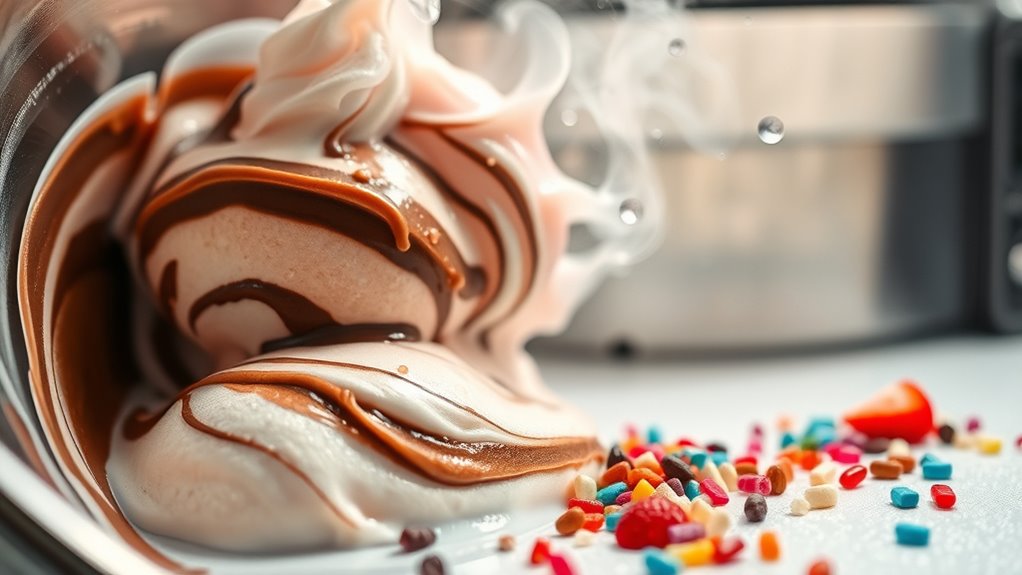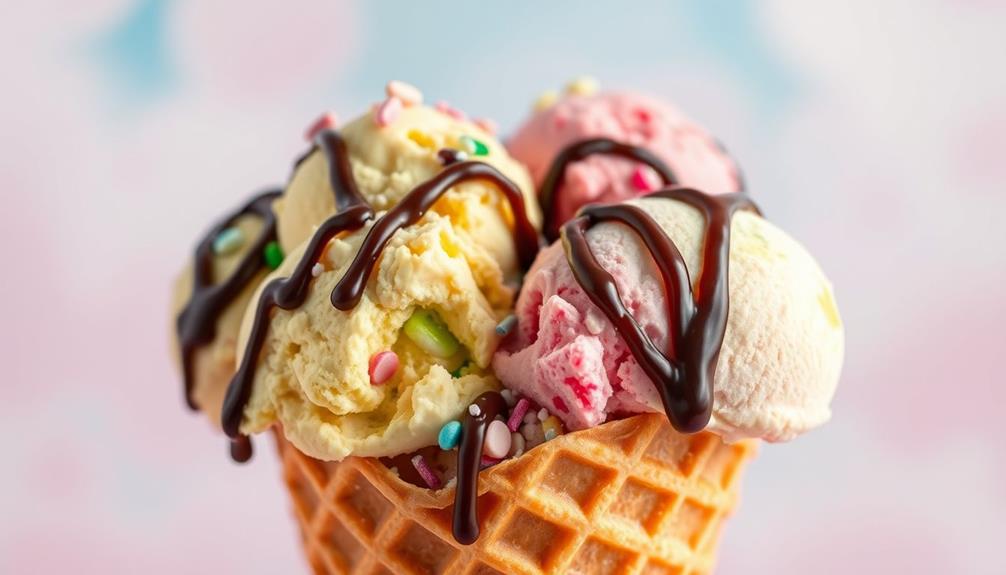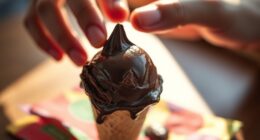The science behind ice cream making involves a delicate mix of ingredients like cream, sugar, and emulsifiers. These elements work together through processes like homogenization and emulsification to create a creamy texture. Freezing techniques play an essential role, ensuring tiny ice crystals form for that smooth finish. Pasteurization enhances flavor and safety, while aging develops richness. Curious about the intricate details of how these elements interact? There’s so much more to uncover!
Key Takeaways
- Ice cream is an emulsion of cream, milk, sugar, and sometimes egg yolks, balancing texture and flavor through careful ingredient interaction.
- Emulsifiers and stabilizers prevent separation and control ice crystal growth, ensuring a smooth, creamy texture in the final product.
- Freezing techniques, such as dynamic freezing, introduce air rapidly to form small ice crystals, enhancing creaminess and preventing hardness.
- Pasteurization and aging processes improve safety, texture, and flavor by hydrating proteins and stabilizers, leading to smaller ice crystals.
- Home and industrial methods differ, with home techniques focusing on manual cooling, while industrial production emphasizes precision and consistency with modern equipment.
Understanding the Main Ingredients
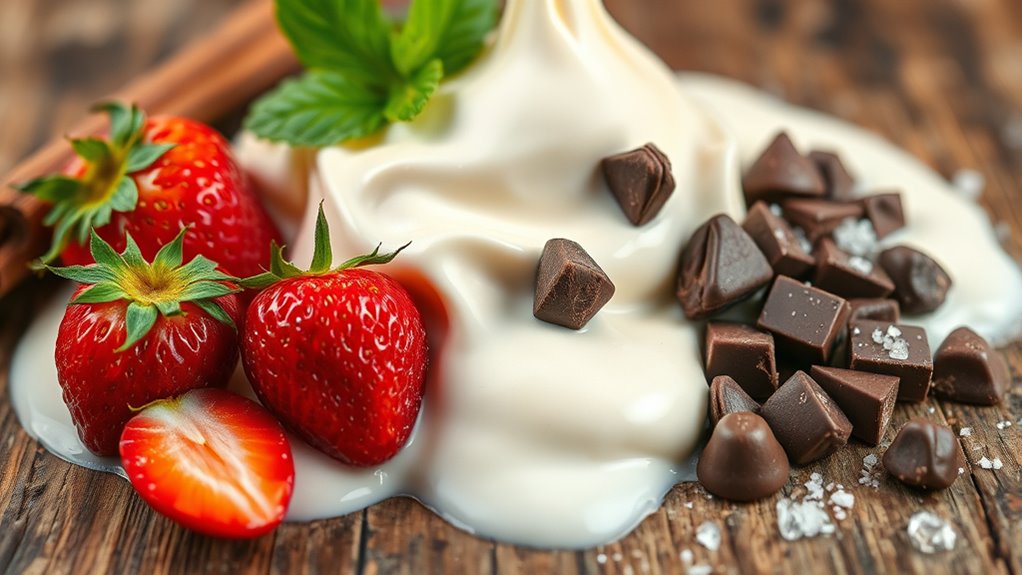
When you immerse yourself in ice cream making, understanding the main ingredients is crucial for achieving the perfect scoop.
Cream is a key player, primarily made up of fatty acids that provide structure and flavor. The fat content stabilizes air bubbles, giving ice cream its creamy texture. You’ll often use heavy cream for its richness, which helps slow the freezing process, guaranteeing a smooth finish. Additionally, the process of butter production relies on similar fat stabilization techniques to achieve desired textures. Often, ice cream can be compared to frozen yogurt in terms of texture and flavor profile, making it a versatile dessert choice.
Cream, rich in fatty acids, creates a creamy texture by stabilizing air bubbles, ensuring a smooth and delightful ice cream experience.
Milk complements cream by adding essential proteins and lactose, enhancing flavor and texture. Whole milk works best, while lactose ensures your ice cream remains scoopable.
Sugar acts as the primary sweetener and lowers the freezing point, preventing hardness. Together, these ingredients create an ideal balance, leading to the delightful treat you crave. Additionally, incorporating egg-enhanced vanilla ice cream can elevate the richness and depth of flavor in your homemade creations.
Emulsification and Homogenization Processes

Emulsification and homogenization play vital roles in creating that smooth, creamy experience you love. Emulsifiers like lecithin and mono- and diglycerides stabilize the oil-in-water mixture, preventing fat and water from separating. They help trap air bubbles, contributing to a drier, more uniform texture while enhancing meltdown resistance. The use of high sugar content in certain recipes can also affect the overall texture and flavor profile of the ice cream. Additionally, the presence of saturated fats in traditional ice cream recipes can impact health considerations for consumers.
Homogenization breaks down milk fat globules under high pressure, ensuring even distribution and a consistent texture. Together, emulsifiers and stabilizers like guar gum manage liquid distribution and prevent ice crystal growth. The use of natural and organic ingredients is becoming increasingly popular in food products, similarly to trends in the beauty industry.
This combination is essential for achieving the ideal quality and shelf life in your favorite ice cream.
Freezing Techniques and Their Importance
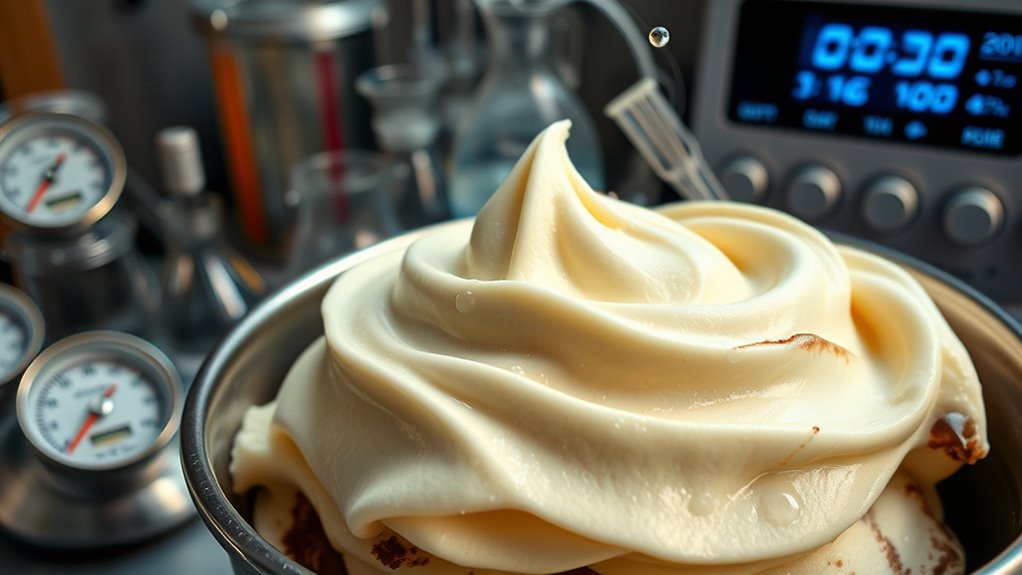
Effective freezing techniques are essential for creating ice cream with the perfect texture and consistency.
Dynamic freezing rapidly freezes your mix while incorporating air, forming small ice crystals for that smooth mouthfeel you love. On the other hand, static freezing controls ice crystal growth during the final freeze, ensuring everything stays consistent. Understanding the importance of temperature fluctuations can also help in achieving that desired creaminess. Additionally, strategic withdrawal timing can optimize overall results in ice cream texture, similar to how tax planning can enhance retirement income.
Pay attention to temperatures; lower coolant temps enhance ice crystal nucleation rates. Freezing the ice cream maker’s bowl helps, and using smaller containers cuts down freezing time, keeping those pesky large crystals at bay.
Remember, controlling temperature fluctuations during storage is crucial, as it minimizes recrystallization and maintains that creamy texture. Additionally, understanding the legal definitions of ice cream can help you choose the right products for optimal texture and flavor.
Master these techniques, and you’ll enjoy ice cream that’s both delicious and perfectly textured.
The Role of Pasteurization and Ageing
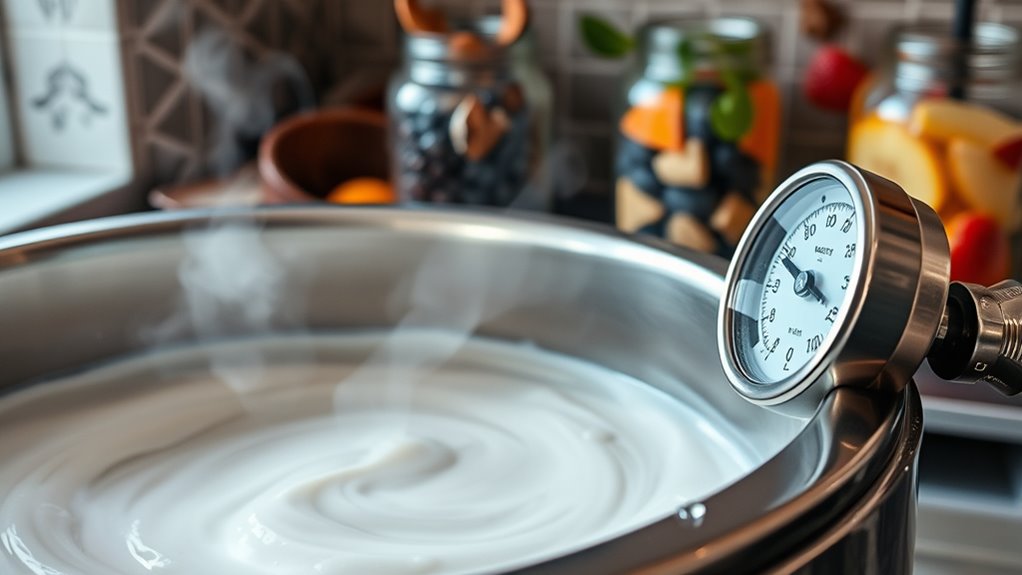
After mastering freezing techniques, it’s time to look at the role of pasteurization and aging in ice cream production.
Pasteurization is essential for eliminating harmful bacteria, enhancing flavor, and improving texture. By heating your mix to 155°F for 30 minutes or 175°F for 25 seconds, you guarantee food safety while denaturing proteins, which results in a smoother texture. Additionally, understanding the health benefits of proper pasteurization can further ensure a safe and delicious product. Implementing retirement savings options can also be beneficial for ice cream makers planning for their future.
Pasteurization is crucial for safety, flavor enhancement, and achieving a smoother texture in ice cream.
Following pasteurization, aging your mix at around 40°F for at least four hours allows proteins and stabilizers to hydrate, leading to smaller ice crystals and a creamier mouthfeel. This process enhances flavor and texture, making your ice cream even more delightful. Both industrial and homemade methods benefit from proper aging, guaranteeing a high-quality product. Additionally, understanding the developmental milestones in food processing can further improve the quality of your ice cream.
Interactions Between Key Ingredients
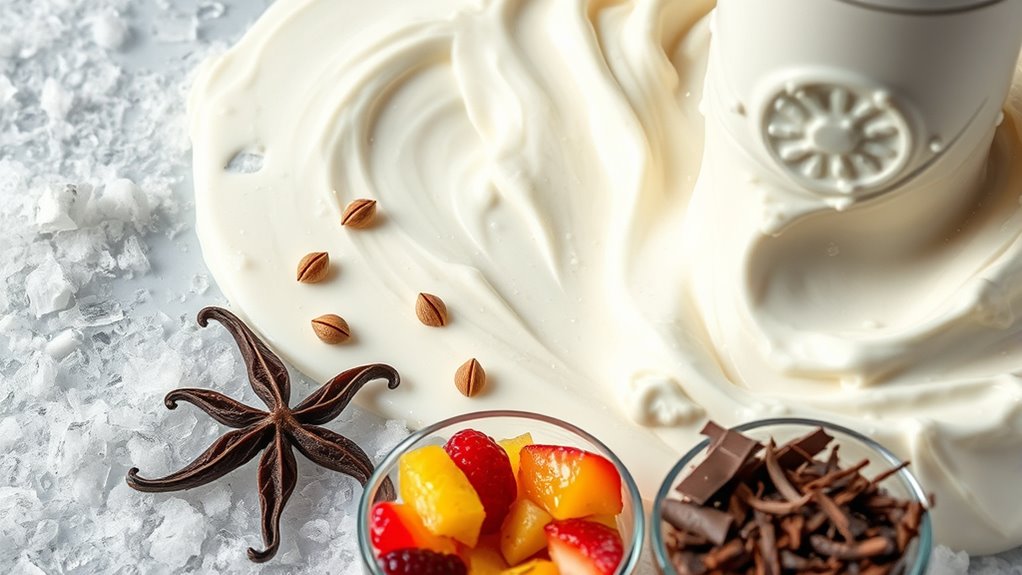
When you combine key ingredients in ice cream making, the interactions between them play a crucial role in determining the final product’s texture and flavor.
Ice crystals, which make up about 30% of ice cream, provide firmness, while air bubbles, incorporated during churning, contribute to a lighter texture. The incorporation of global flavors can elevate your ice cream and offer unique taste experiences.
Fat globules enrich flavor and trap air, enhancing softness. Regular consumption of ice cream, especially varieties high in sugar and fat, can lead to health issues such as weight gain and diabetes.
Sugar lowers the freezing point, preventing a hard texture and adding sweetness. Emulsifiers like egg yolks guarantee smooth mixing of fat and water, preventing separation.
Stabilizers, such as guar gum, maintain texture by preventing ice crystal growth. Together, these interactions create the balance needed for that creamy, delightful experience you crave in every scoop. Additionally, the choice of ice cream flavors can significantly influence the final taste and texture due to the varying compositions of sugar and fat in different recipes.
Experimental and Practical Applications
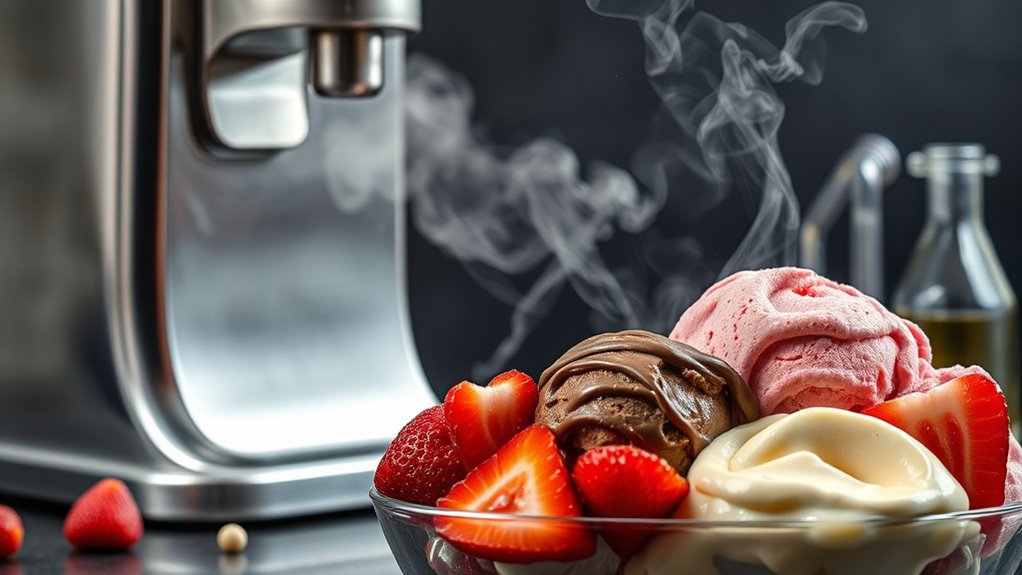
While experimenting with ice cream recipes, you can uncover fascinating insights into the science behind this beloved treat.
You’ll find that ice cream is an emulsion of fat, water, and air, and using emulsifiers like lecithin enhances stability. By isolating variables, such as air content and stabilizers, you can assess their impacts on texture and melting rates. Collecting data from multiple trials helps refine your recipe. Additionally, the process of decluttering spaces can lead to a more focused and organized environment, allowing for a smoother ice cream-making experience. Understanding causes of difficult behavior in seniors can also encourage you to create a calm atmosphere during your ice cream-making sessions to enhance enjoyment.
Ice cream is a delicate emulsion; tweaking air content and stabilizers can transform texture and melting properties.
Practical applications at home include using salt and ice to rapidly lower freezing points, maintaining specific temperatures for consistency, and shaking the mixture to prevent large ice crystals. Understanding the importance of skin hydration can enhance your overall sensory experience while enjoying your homemade frozen treats.
Adding diverse ingredients can modify flavor without affecting the freezing process, making your ice cream experiments both fun and educational.
Industrial Techniques for Consistent Quality

To achieve consistent quality in ice cream production, manufacturers rely on a combination of precise techniques and advanced equipment.
Key ingredients like cream and milk solids provide richness and texture, while sugar controls freezing points and ice crystal size. The increasing focus on sustainable fashion has parallels in ice cream production, where eco-friendly sourcing of ingredients is becoming a priority. Additionally, the use of natural ingredients promotes a healthier product that appeals to environmentally conscious consumers.
Pasteurization and homogenization guarantee safety and uniformity by killing bacteria and breaking down fat molecules.
After pasteurization, the mix cools rapidly, often to 5°C, allowing flavors to develop during the aging process.
Dynamic freezing methods incorporate air to create small ice crystals, essential for smooth texture.
Continuous freezers enable mass production, while batch freezers offer flexibility.
Finally, blast freezing tunnels quickly harden the ice cream, confirming it meets the highest quality standards before reaching consumers. The role of support systems in ensuring product consistency can be likened to the importance of therapy and community in end-of-life care.
Frequently Asked Questions
What Are the Best Flavors for Homemade Ice Cream?
When you’re making homemade ice cream, the best flavors to try are those that inspire you.
Consider classic options like strawberry or peach for a fruity twist. If you’re feeling adventurous, mix in unique combinations like coffee and donuts or lavender Earl Grey.
Don’t forget about nutty options like chocolate peanut butter or pistachio.
Experimenting with ingredients like crushed cereal or cookie pieces can elevate your creation to something truly special.
Enjoy the process!
How Long Does Homemade Ice Cream Last in the Freezer?
When it comes to homemade ice cream, you’ve got to keep an eye on the clock. Generally, it lasts about 2 to 4 weeks in the freezer.
If you’re not careful, the quality can take a nosedive after a month. To guarantee it stays fresh, store it in airtight containers and keep it at a steady temperature.
Can I Use Dairy Alternatives for Ice Cream?
Absolutely, you can use dairy alternatives for ice cream! Options like coconut milk or almond milk work great, providing creamy textures and unique flavors.
Coconut milk’s high fat content creates a rich consistency, while almond milk offers a lighter option.
Just remember to experiment with sweeteners and stabilizers to achieve the perfect texture.
With a little creativity, you’ll whip up delicious dairy-free ice cream that everyone can enjoy!
What Kitchen Tools Are Essential for Making Ice Cream?
To make ice cream, you’ll need a few essential kitchen tools.
Start with mixing bowls and digital scales for accurate measurements. A whisk or fork helps incorporate ingredients, while a blender or food processor guarantees a smooth base.
An ice cream machine is key for freezing, and ice cream scoops make serving easy.
Don’t forget sieves to achieve that creamy texture and oven mitts to handle cold containers safely.
Enjoy your homemade treat!
How Can I Prevent Ice Crystals in My Ice Cream?
To prevent ice crystals in your ice cream, guarantee you’re freezing it quickly.
Use an ice cream maker that chills well, and keep your mixture cold before pouring it in.
Wrap your ice cream tightly in plastic wrap to block moisture, and store it in the coldest part of your freezer.
Avoid refreezing melted ice cream, as that can lead to larger crystals.
Maintaining low temperatures during storage is key for a smooth texture.
Conclusion
To conclude, making ice cream is a fascinating blend of science and art. By understanding the key ingredients and processes like emulsification and pasteurization, you can appreciate the complexity behind your favorite treat. Did you know that the global ice cream market was valued at over $70 billion in 2021? That’s a proof of how much we love this creamy delight! So, the next time you enjoy a scoop, remember the intricate science that makes it possible.
